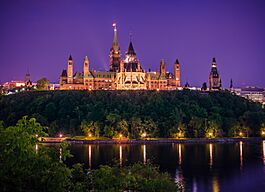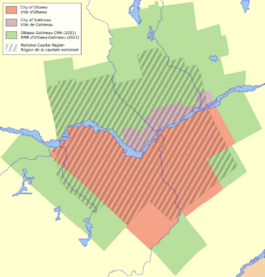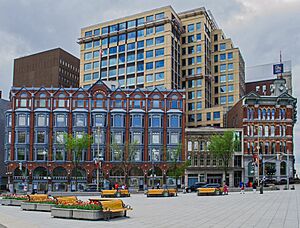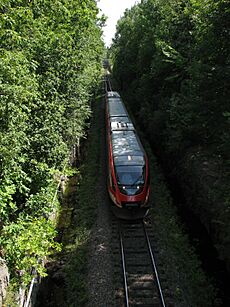National Capital Region (Canada) facts for kids
Quick facts for kids
National Capital Region
Région de la capitale nationale
|
|
|---|---|
|
Metropolitan area
|
|

|
|

National Capital Region (striped area)
|
|
| Country | Canada |
| Provinces | Ontario Quebec |
| Principal cities | Ottawa, ON Gatineau, QC |
| Area | |
| • Metro | 8,046.99 km2 (3,106.96 sq mi) |
| Elevation | 70–556 m (230–1,825 ft) |
| Population | |
| • Metro | 1,488,307 |
| • Metro density | 185.0/km2 (479/sq mi) |
| GDP | |
| • Ottawa–Gatineau CMA | CA$ 89.9 billion (2020) |
| Time zone | UTC-5 (EST) |
| • Summer (DST) | UTC-4 (EDT) |
| Area code(s) | 343, 468, 613, 753, 819, 873 |
The National Capital Region (NCR) is also known as Canada's Capital Region or Ottawa–Gatineau. It is a special area set up by the Canadian government. It includes Ottawa, which is the capital city of Canada in Ontario. It also includes the nearby city of Gatineau in Quebec. The NCR also covers the towns and areas around these two cities.
Even though it has a special name, the NCR is not a separate province or territory. It is part of both Ontario and Quebec. The National Capital Act (1985) officially defines this region. It covers about 4,715 square kilometers (1,820 square miles). The Ottawa River runs through the region and acts as the border between Ontario and Quebec. The Ottawa–Gatineau area is the only major city area in Canada that crosses provincial borders.
Contents
History of the Capital Region
The Algonquin Indigenous people lived in the Ottawa-Gatineau area first. The first European settlement began on March 7, 1800. Philemon Wright from Massachusetts arrived with his family and workers. They started a farming community on the north side of the Ottawa River, in what is now Hull, Quebec. This was near the Chaudière Falls.
The National Capital Region was officially created by the National Capital Act in 1985.
Geography and Climate
Ottawa is in a part of Southern Ontario called Eastern Ontario. Gatineau is in southwestern Quebec. Even though Ontario is generally west of Quebec, the border here means Gatineau is north of Ottawa. It is also northwest of Ottawa's city center.
The National Capital Region is where the Canadian shield and the Saint Lawrence Lowlands meet. This area has several major fault lines. Small earthquakes happen somewhat regularly here. For example, a notable earthquake happened in Quebec in 2010. The Gatineau Hills are also in this region. They are the lower hills of the Laurentian Mountains.
Climate in the Capital Region
The National Capital Region has four clear seasons: spring, summer, autumn, and winter. In Ottawa, the average high temperature in July is about 26.6 °C (80 °F). The average low temperature in January is around −14.4 °C (6.1 °F). In Gatineau, July's average high is 26 °C (78.8 °F). January's average low is −15 °C (5 °F).
People and Languages
Most of the National Capital Region is known as a bilingual area. This means that both English and French are used for federal government work.
The City of Ottawa also has a policy to support both languages. About 19% of people in Ottawa speak French as their first language. However, 40% of the city's population can speak both English and French.
Gatineau is one of the most bilingual cities in Canada. About 64% of its population can speak both English and French. The region has a mix of English-speaking areas (like Ottawa) and French-speaking areas (like Gatineau).
In 2021, the Ottawa-Gatineau area had a population of about 1,488,307 people. This was a growth of about 8.5% since 2016.
Economy
Technology Hub
From 1990 to 2000, Ottawa was home to many successful tech companies. These included Nortel Networks, JDS Uniphase, and Newbridge Networks. The number of jobs in high-tech doubled in just five years, reaching 80,000 by 2001. This period was sometimes called "Silicon Valley North."
After 2002, some of these companies faced challenges. However, Ottawa still has a strong tech presence today. Companies like Shopify, Halogen Software, and Kinaxis Inc. are based here. There are over 1,700 other technology companies in the city.
National Capital Commission

The National Capital Commission (NCC) is a special group set up by the Canadian government in 1959. Its job is to manage federal buildings and land in the National Capital Region. The NCC helps make the region a source of pride and unity for all Canadians. It works on planning for land use, culture, and other important matters.
In 2006, the NCC finished work on Confederation Boulevard. This is a special route that connects important places in the NCR on both sides of the Ottawa River. The NCC also restored the NCC River House, which was built in 1914. It is located near the Ottawa River.
The NCC reports to the Canadian Parliament through the Minister of Heritage. Its main office is in the Chambers Building in Ottawa.
Fun Places to Visit

The National Capital Region has many exciting attractions. These include festivals, national museums, famous buildings, sports, and entertainment. Ottawa is known for its beautiful Gothic Revival style buildings.
Festivals and Events
Every year, the region hosts many fun events. These include the music festival Bluesfest and the winter festival Winterlude. There is also the Canadian Tulip Festival, Capital Pride, and the RCMP Musical Ride. In Gatineau, you can enjoy the Gatineau Hot Air Balloon Festival. The biggest Canada Day celebrations in the country also happen here.
Famous Buildings and Museums
The region is home to several national museums. You can visit the Canadian Museum of History, Canadian War Museum, and Canadian Museum of Nature. There is also the Canada Science and Technology Museum, the National Art Gallery, and the Canada Aviation Museum.
Important buildings include Parliament Hill, where Canada's government works. You can also see the Prime Minister's home at 24 Sussex Drive and the Governor General's home at Rideau Hall. Other famous places are the Supreme Court of Canada and the Royal Canadian Mint.
There are 29 National Historic Sites of Canada in the region. These are places with special historical importance.
Sports and Entertainment
The NCR has many sports teams. These include the Ottawa Senators (NHL hockey) and the Ottawa Redblacks (CFL football). There is also Atlético Ottawa (CPL soccer). Junior hockey teams like the Ottawa 67's (OHL) and teams from the Quebec Maritimes Junior Hockey League (QMJHL) also play here.
Universities like Carleton University and the University of Ottawa have strong sports teams. Their teams, like the Carleton Ravens and Ottawa Gee-Gees, are well-known. Algonquin College has also won many national championships.
Getting Around
The National Capital Region has several major highways. These include Highway 417 and Highway 416 in Ontario. In Quebec, there are Autoroute 5 and Autoroute 50.
Public transportation is managed by OC Transpo in Ottawa (Ontario side) and the STO in Gatineau (Quebec side). These systems serve over 1.1 million people.
OC Transpo operates a light rail transit (LRT) system called the O-Train. It has two lines. The Trillium Line runs north-south. The Confederation Line connects the western and eastern parts of Ottawa through downtown. It has 13 stations, with 3 of them underground. There are plans for an LRT system in Gatineau that would connect to Ottawa's O-Train lines.
Gatineau also has a bus transitway called the Rapibus, which started in 2013. Both OC Transpo and STO operate many buses that serve the region. Some STO bus routes even cross into downtown Ottawa.
The main international airport for the NCR is Ottawa Macdonald–Cartier International Airport. In 2023, over 4 million passengers used it. It offers flights to many places in Canada, the United States, the Caribbean, and Europe. It is also a key airport for busy routes to Montreal-Pierre Elliott Trudeau International Airport and Toronto Pearson International Airport.
Phone Numbers
The Ontario side of the National Capital Region uses 613, 343, and 753. The Quebec side uses 819, 873, and 468.
Even though you now need to dial ten digits for local calls, federal government numbers still allow for easy calling across the provincial border.
Local News
Three main daily newspapers are printed in Ottawa. Two are in English: the Ottawa Citizen and the Ottawa Sun. One is in French: Le Droit.
Ideas for a Capital District
There have been ideas to make the National Capital Region a separate "capital district." This would be similar to Washington, D.C. in the United States. However, these ideas have not gained much support recently. As of 2024, there is no active movement to create a separate capital district.
Images for kids
-
Rideau Canal in Ottawa
See also
 In Spanish: Región de la Capital Nacional (Canadá) para niños
In Spanish: Región de la Capital Nacional (Canadá) para niños









